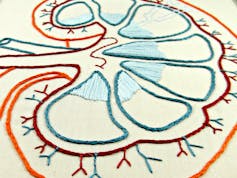End-stage renal disease is a devastating illness that happens when the kidneys stop working. It is primarily caused by diabetes and high blood pressure and is on the increase. When the kidneys fail, people have to make a stark choice: take up treatment or a transplant, or die.
Treatments include haemodialysis, a demanding intervention that removes waste products and fluid which accumulate in the blood when the kidneys fail. It is usually carried out in hospital three times a week, indefinitely, with each session lasting around four hours. Peritoneal dialysis is another treatment where the lining of the abdomen acts as a filter and waste is removed by means of a cleansing fluid called dialysate, washed in and out of the abdomen in cycles. It is home-based and requires a level of dexterity, training and an ability to perform the treatment steps safely.
Kidney transplantation is the treatment of choice, but is not available to many patients who are frail and often suffering other illnesses such as advanced cardiac failure. These patients would likely not survive a transplant and may also find dialysis challenging. One problem with opting for dialysis is that it can also shorten life, particularly for those people with other problems such as heart disease. It is physically and emotionally draining, causes complications such as nerve problems, anaemia, bone disease and infection. In addition, an arduous regime of three days a week on dialysis can lead to symptoms including nausea, vomiting, cramps and depression. Subsequently some people end up in very poor health and others will die.
This has led to a fourth choice for patients – the “no dialysis” option where people opt for a supportive and palliative care provided by the multidisciplinary team, usually in liaison with a community palliative care team and their GP. For some patients this decision is easy to make, particular those who are old and frail and don’t wish to attend hospital three times a week, but for many it is a complex, multi-faceted choice, fraught with difficulty.
Some patients may be advised against dialysis while others remain undecided for some time – though we know that if dialysis is not started (and we can’t always be sure it will extend life) certain death will ensue.
The best care

Models of multidisciplinary care for supporting and providing palliative care for those with end-stage renal disease have developed mainly in England and in Australia and the approach is being developed in Northern Ireland. Yet we don’t know how many people are opting for this kind of care in preference to dialysis. Other parts of Europe have been slow to adopt this practice and it is likely that some people are advised to take up dialysis in order to prolong life, when it may not be the best option for them.
It is starting to be recognised that some people with ESRD will not benefit from dialysis, particularly because it can shorten life. The difficulty is in identifying those for whom dialysis might hasten death. Increasing frailty, additional co-morbidities and poor functional status is likely to reduce your chance of effective dialysis.
Quality of life is another important issue. In order to help people make informed heath decisions we need to understand how quality of life is affected by treatments such as haemodialysis, peritoneal dialysis or palliative care with more research undertaken to explore these important questions – we can start by comparing these populations by following them over time in order to observe experiences and changes that happen.
Also key is the impact on carers when people opt out of dialysis. Carers, an often forgotten group, may be as frail as, or frailer than the person they are caring for as they are often spouses – and people opting not to use dialysis are usually in an older age-group. Sometimes carers die before the person with renal disease.
Many carers sacrifice social and personal health needs in order to care for their loved one and we know little about how they cope and what interventions might help improve the experience.
More than counting costs
The other important thing to bear in mind is that when making decisions about healthcare treatments, costs cannot be ignored in an impoverished NHS. Haemodialysis costs about £35,000 and peritoneal dialysis £20,000-a-year per patient. We do not know how much it costs to manage a patient in palliative care as this has not been studied, but it is likely to be much cheaper. That said, prices shouldn’t dictate treatment decisions but should be made based on the best interests of the patient. Many patients making decisions about treatments for ESRD are also frail, have poor performance scores and impaired cognition, and may not do well on a dialysis machine.
The PACKS study, of which I’m a contributor, is a welcome piece of research. The study aims to examine quality of life, decision making, costs and mortality in patients with ESRD who have opted for palliative care. It will also explore care decisions made by patients from the perspective of the patient, carer and healthcare professionals, from the start of palliative care. An economic analysis gives greater transparency of how resources are allocated for people with ESRD, and it will lay the ground work for further work which should ultimately compare patients who opt for dialysis with those who opt for palliative care. When we’re better able to compare outcomes in these two groups, it will help us make sure that the options people have are the best ones for them.

